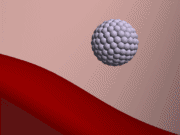|
Conception
|
|
Implantation
|
|
|
|
|
Implantation:
The blastocyst implants itself in the uterine lining.
|
|
After its arrival in the uterus, the blastocyst continues to develop until, after another three to four days, it is ready to attach itself to the uterine lining. About one week after fertilization this attachment begins, and after about another week the blastocyst has completely buried itself in the nourishing tissues that cover the inner surface of the uterus (the endometrium). The entire extended process of the blastocyst burying itself in the uterine lining is called implantation, and it accomplishes pregnancy.
An implantation can occur only under certain proper conditions. For example, if the zygote should reach the uterus before it has developed into a blastocyst, no implantation is possible and pregnancy cannot be established. The same is true if the uterine lining is not prepared to receive the blastocyst. In both cases, the cell cluster will simply die and disintegrate.
In some very rare instances, the blastocyst will attach itself not to the uterine wall but to the inside of the Fallopian tube or some other place outside the uterus, i.e., in the abdominal cavity. The result is called ectopic pregnancy, which cannot produce a live child and is dangerous to the woman. Therefore, ectopic (Greek ek: out + topos: place = out of place) pregnancies have to be terminated by surgery.
|


